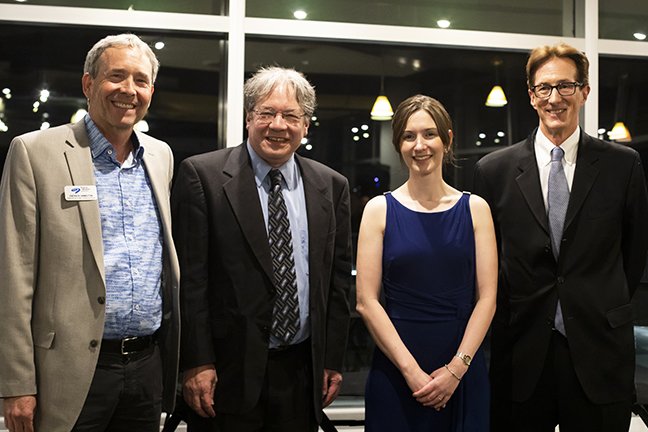CSE Regents Professor, alumna appear in Omnitheater film

Above: Regents Professor R. Lawrence Edwards in his Isotope Geochemistry laboratory at the University of Minnesota Twin Cities. The lab—renowned for its precision rock dating techniques—appears in the Science Museum of Minnesota's latest Omnitheater film Ancient Caves.
Photos courtesy: MacGillivray Freeman Films
Professor Edwards' Th-230 dating methods used to “read” cave information
March 6, 2020
When the film Ancient Caves plays in the Science Museum of Minnesota’s Omnitheater (March 6-May 24, 2020), College of Science and Engineering Regents Professor R. Lawrence Edwards and alumna Katee Wendt will appear on the big screen.
The film follows the work of British geologist and spelunker Gina Moseley, a frequent colleague of Edwards who unearths—literally—the world’s climate history locked away in ancient cave deposits around the globe. But no history can be written without a timeline, and that’s where Edwards’ precision rock dating techniques have proven invaluable.
In fact, his methods have driven the whole field of reconstructing climate history from cave rocks.
“The layers in cave deposits are time capsules containing information about climate, but you would not know when the time capsule was made without these dates,” says Edwards, of the Department of Earth and Environmental Sciences.
For decades Edwards has developed and improved dating methods based on detecting vanishingly small amounts of the radioactive elements uranium and thorium. It can be said that his laboratory—which appears in Ancient Caves—is the place in the world for applying these dating methods. Edwards was also filmed in Spring Valley Caverns, south of Rochester, Minnesota.

Bedrock methodology
Edwards’ methods have helped Moseley document and explain the causes of abrupt climate change, which can happen worldwide over scales of years or decades.
“These are episodes when climate experienced a tipping point, now well documented—including Gina’s work—in climate history, and the kind of event that, we are worried, could present itself in the next couple centuries,” Edwards says.
His methods also helped Moseley and colleagues demonstrate that warming at Devils Hole, part of Death Valley National Park, coincided with the melting of the great Northern Hemisphere ice sheets of the glacial period before last.
“This had been a contentious issue until her work,” Edwards says.
Moseley and Wendt, who received B.S. and M.S. degrees in environmental sciences from the University of Minnesota, are at the Institute of Geology, University of Innsbruck (Austria).
Making of a film
Ancient Caves director Jonathan Bird’s first scientific contact was Edwards, whom he interviewed on his cave research. Edwards arranged for Bird’s group to film at Spring Valley Caverns, with permission from John Ackerman, who owns the cave. Edwards first met Ackerman through Professor Emeritus Calvin Alexander, a veteran cave expert and departmental colleague of Edwards who has also conducted research in the Spring Valley area.
“There is a whole string of connects that eventually led to Spring Valley being highlighted in this film,” says Edwards. “I also put him [Bird] in contact with Gina Moseley, who ended up starring in Ancient Caves. She, in turn, helped get permission to film in other caves, notably Devils Hole, which is under the purview of the National Park Service. Jonathan also … received permission to film the campus by drone.
“All of the footage, in and out of caves, is remarkable.”
Story by Deane Morrison
Ancient Caves Trailer from Science Museum of Minnesota on Vimeo.
